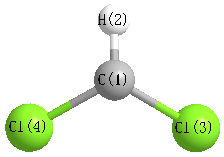Jump to
S1C2
Energy calculated at QCISD(T)/cc-pVDZ
| | hartrees |
|---|
| Energy at 0K | -957.835050 |
| Energy at 298.15K | |
| HF Energy | -957.402177 |
| Nuclear repulsion energy | 124.468414 |
The energy at 298.15K was derived from the energy at 0K
and an integrated heat capacity that used the calculated vibrational frequencies.
Vibrational Frequencies calculated at QCISD(T)/cc-pVDZ
| Mode Number |
Symmetry |
Frequency
(cm-1) |
Scaled Frequency
(cm-1) |
IR Intensities
(km mol-1) |
Raman Act
(Å4/u) |
Dep P |
Dep U |
|---|
| 1 |
A1 |
3272 |
3118 |
|
|
|
|
| 2 |
A1 |
751 |
716 |
|
|
|
|
| 3 |
A1 |
307 |
293 |
|
|
|
|
| 4 |
B1 |
443i |
423i |
|
|
|
|
| 5 |
B2 |
1233 |
1175 |
|
|
|
|
| 6 |
B2 |
935 |
891 |
|
|
|
|
Unscaled Zero Point Vibrational Energy (zpe) 3027.1 cm
-1
Scaled (by 0.9531) Zero Point Vibrational Energy (zpe) 2885.1 cm
-1
See section
III.C.1 List or set vibrational scaling factors
to change the scale factors used here.
See section
III.C.2
Calculate a vibrational scaling factor for a given set of molecules
to determine the least squares best scaling factor.
Geometric Data calculated at QCISD(T)/cc-pVDZ
Point Group is C2v
Cartesians (Å)
| Atom |
x (Å) |
y (Å) |
z (Å) |
|---|
| C1 |
0.000 |
0.000 |
0.680 |
| H2 |
0.000 |
0.000 |
1.772 |
| Cl3 |
0.000 |
1.490 |
-0.172 |
| Cl4 |
0.000 |
-1.490 |
-0.172 |
Atom - Atom Distances (Å)
| |
C1 |
H2 |
Cl3 |
Cl4 |
| C1 | | 1.0915 | 1.7166 | 1.7166 |
H2 | 1.0915 | | 2.4494 | 2.4494 | Cl3 | 1.7166 | 2.4494 | | 2.9798 | Cl4 | 1.7166 | 2.4494 | 2.9798 | |
 More geometry information
More geometry information
Calculated Bond Angles
| atom1 |
atom2 |
atom3 |
angle |
|
atom1 |
atom2 |
atom3 |
angle |
| Cl3 |
C1 |
H2 |
119.781 |
|
Cl3 |
C1 |
Cl4 |
120.439 |
| Cl4 |
C1 |
H2 |
119.781 |
|
Electronic energy levels
Charges, Dipole, Quadrupole and Polarizability
Jump to
S1C1
Energy calculated at QCISD(T)/cc-pVDZ
| | hartrees |
|---|
| Energy at 0K | -957.836502 |
| Energy at 298.15K | -957.837347 |
| HF Energy | -957.404168 |
| Nuclear repulsion energy | 124.305361 |
The energy at 298.15K was derived from the energy at 0K
and an integrated heat capacity that used the calculated vibrational frequencies.
Vibrational Frequencies calculated at QCISD(T)/cc-pVDZ
| Mode Number |
Symmetry |
Frequency
(cm-1) |
Scaled Frequency
(cm-1) |
IR Intensities
(km mol-1) |
Raman Act
(Å4/u) |
Dep P |
Dep U |
|---|
| 1 |
A' |
3222 |
3071 |
|
|
|
|
| 2 |
A' |
759 |
724 |
|
|
|
|
| 3 |
A' |
556 |
529 |
|
|
|
|
| 4 |
A' |
302 |
288 |
|
|
|
|
| 5 |
A" |
1236 |
1178 |
|
|
|
|
| 6 |
A" |
899 |
857 |
|
|
|
|
Unscaled Zero Point Vibrational Energy (zpe) 3487.0 cm
-1
Scaled (by 0.9531) Zero Point Vibrational Energy (zpe) 3323.4 cm
-1
See section
III.C.1 List or set vibrational scaling factors
to change the scale factors used here.
See section
III.C.2
Calculate a vibrational scaling factor for a given set of molecules
to determine the least squares best scaling factor.
Geometric Data calculated at QCISD(T)/cc-pVDZ
Point Group is Cs
Cartesians (Å)
| Atom |
x (Å) |
y (Å) |
z (Å) |
|---|
| C1 |
0.014 |
0.710 |
0.000 |
| H2 |
-0.540 |
1.655 |
0.000 |
| Cl3 |
0.014 |
-0.174 |
1.485 |
| Cl4 |
0.014 |
-0.174 |
-1.485 |
Atom - Atom Distances (Å)
| |
C1 |
H2 |
Cl3 |
Cl4 |
| C1 | | 1.0957 | 1.7279 | 1.7279 |
H2 | 1.0957 | | 2.4202 | 2.4202 | Cl3 | 1.7279 | 2.4202 | | 2.9697 | Cl4 | 1.7279 | 2.4202 | 2.9697 | |
 More geometry information
More geometry information
Calculated Bond Angles
| atom1 |
atom2 |
atom3 |
angle |
|
atom1 |
atom2 |
atom3 |
angle |
| Cl3 |
C1 |
H2 |
116.189 |
|
Cl3 |
C1 |
Cl4 |
118.483 |
| Cl4 |
C1 |
H2 |
116.189 |
|
Electronic energy levels
Charges, Dipole, Quadrupole and Polarizability
